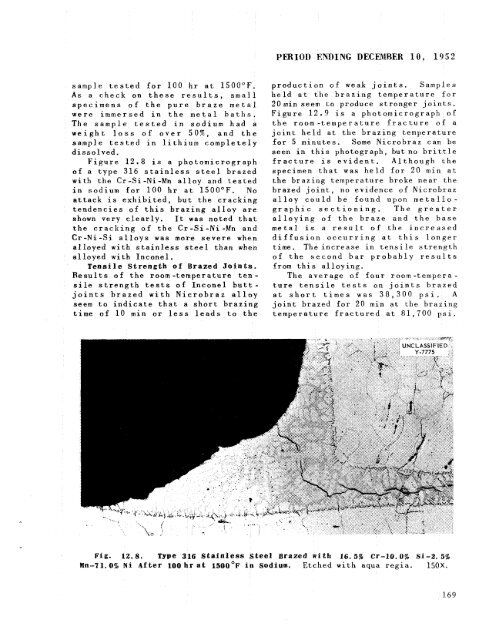the Molten Salt Energy Technologies Web Site
the Molten Salt Energy Technologies Web Site
the Molten Salt Energy Technologies Web Site
Create successful ePaper yourself
Turn your PDF publications into a flip-book with our unique Google optimized e-Paper software.
sample tested for 100 hr at 1500°F.<br />
As a check on <strong>the</strong>se results, small<br />
specimens of <strong>the</strong> pure braze metal<br />
were immersed in <strong>the</strong> metal baths.<br />
The sample tested in sodium had a<br />
weight loss of over SOX, and <strong>the</strong><br />
sample tested in lithium completely<br />
dissolved.<br />
Figure 12.8 is a photomicrograph<br />
of a type 316 stainless steel brazed<br />
with <strong>the</strong> Cr-Si-Ni-Mn alloy and tested<br />
in sodium for 100 hr at 1500°F. No<br />
attack is exhibited, but <strong>the</strong> cracking<br />
tendencies of this brazing alloy are<br />
shown very clearly. It was noted that<br />
<strong>the</strong> cracking of <strong>the</strong> Cr-Si-Ni-Mn and<br />
Cr-Ni-Si alloys was more severe when<br />
alloyed with stainless steel than when<br />
a1 loyed with Inconel.<br />
Tensile Strength of Brazed Joints.<br />
Results of <strong>the</strong> room -temperature ten -<br />
sile strength tests of Inconel butt-<br />
joints brazed with Nicrobraz alloy<br />
seem to indicate that a short brazing<br />
time of 10 min or less leads to <strong>the</strong><br />
PERIOD ENDING DECEMBER 310, 1952<br />
production of weak joints. Samples<br />
held at <strong>the</strong> brazing temperature for<br />
20 min seem LO produce stronger joints.<br />
Figure 12.9 i s a photomicrograph of<br />
<strong>the</strong> room -temperature fracture of a<br />
joint held at <strong>the</strong> brazing t,emperature<br />
for 5 minutes. Some Nicrobraz can be<br />
seen in this photograph, but no brittle<br />
fracture is evident. Although <strong>the</strong><br />
specimen that was held for 20 min at<br />
<strong>the</strong> brazing temperature broke near <strong>the</strong><br />
brazed joint, no evidence of Nicrobraz<br />
alloy could be found upon metallo-<br />
graphic sectioning. The greater<br />
alloying of <strong>the</strong> braze and <strong>the</strong> base<br />
metal is a result of <strong>the</strong> increased<br />
diffusion occurring at this longer<br />
time. The increase in tensile strength<br />
of <strong>the</strong> second bar probably results<br />
from t h i s a1 1 oy ing I<br />
The average of four room-temperature<br />
tensile tests on joints brazed<br />
at short times was 38,300 psi. A<br />
joint brazed for 20 min at <strong>the</strong> brazing<br />
temperature fractured at 81,100 psi.<br />
Fig. 12.8. Type 316 Stainless Steel Brazed with 16.5% Cr-la. 0% Si-2. 55%<br />
Wn-ll.O$ N i After 100 hr at lSOO°F in sodium. Etched with aqua regia. 150X.<br />
169



![Review of Molten Salt Reactor Physics Calculations [Disc 2]](https://img.yumpu.com/21979492/1/190x247/review-of-molten-salt-reactor-physics-calculations-disc-2.jpg?quality=85)












